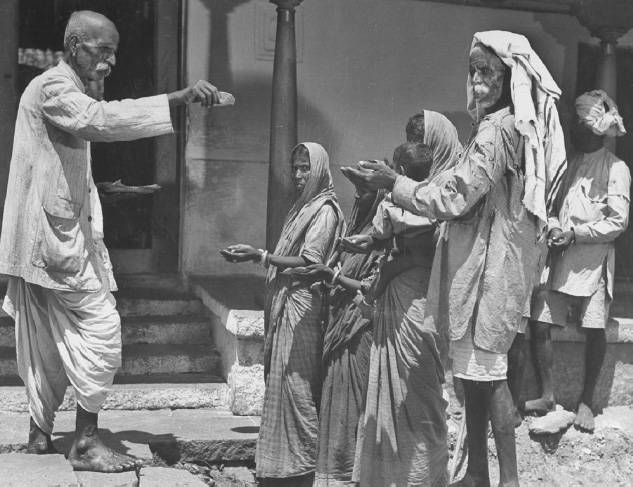Caste as Varna

The origins of the caste system are at best hazy. An earlier idea—that caste evolved from a racially defined encounter between light-skinned Aryan invaders and the darker-hued native peoples—has been challenged in recent years, but no clear alternative theory has emerged. Perhaps the best we can say at this point is that the distinctive social system of India grew out of the interactions among South Asia’s immensely varied cultures together with the development of economic and social differences among these peoples as the inequalities of “civilization” spread throughout the Ganges River valley and beyond. Notions of race, however, seem less central to the growth of the caste system than those of economic specialization and of culture.
Whatever the precise origins of the caste system, by around 500 B.C.E., the idea that society was forever divided into four ranked classes, or varnas, was deeply embedded in Indian thinking. Everyone was born into and remained within one of these classes for life. At the top of this hierarchical system were the Brahmins, priests whose rituals and sacrifices alone could ensure the proper functioning of the world. They were followed by the Kshatriya class, warriors and rulers charged with protecting and governing society. Next was the Vaisya class, originally commoners who cultivated the land. These three classes came to be regarded as pure Aryans and were called the “twice-born,” for they experienced not only a physical birth but also formal initiation into their respective varnas and status as people of Aryan descent. Far below these twice-born in the hierarchy of varna groups were the Sudras, native peoples incorporated into the margins of Aryan society in very subordinate positions. Regarded as servants of their social betters, they were not allowed to hear or repeat the Vedas or to take part in Aryan rituals. So little were they valued that a Brahmin who killed a Sudra was penalized as if he had killed a cat or a dog.
According to varna theory, these four classes were formed from the body of the god Purusha and were therefore eternal and changeless. Although these divisions are widely recognized in India even today, historians have noted considerable social flux in ancient Indian history. Members of the Brahmin and Kshatriya groups, for example, were frequently in conflict over which ranked highest in the varna hierarchy, and only slowly did the Brahmins emerge clearly in the top position. Although theoretically purely Aryan, both groups absorbed various tribal peoples as Indian civilization expanded. Tribal medicine men or sorcerers found a place as Brahmins, while warrior groups entered the Kshatriya varna. The Vaisya varna, originally defined as cultivators, evolved into a business class with a prominent place for merchants, while the Sudra varna became the domain of peasant farmers. Finally a whole new category, ranking lower even than the Sudras, emerged in the so-called untouchables, men and women who did the work considered most unclean and polluting, such as cremating corpses, dealing with the skins of dead animals, and serving as executioners.
Snapshot Social Life and Duty in Classical India
Much personal behavior in classical India, at least ideally, was regulated according to caste. Each caste was associated with a particular color, with a part of the body of the god Purusha, and with a set of duties.
| Caste (Varna) | Color/Symbolism | Part of Purusha | Duties |
|---|---|---|---|
| Brahmin | white/spirituality | head | priests, teachers |
| Kshatriya | red/courage | shoulders | warriors, rulers |
| Vaisya | yellow/wealth | thighs | farmers, merchants, artisans |
| Sudra | black/ignorance | feet | labor |
| Untouchables(outside of the varna system; thus no color and not associated with Purusha) | — | — | polluted labor |
| Beyond caste, behavior was ideally defined in terms of four stages of life, at least for the first three varna groups. Each new stage was marked by a samskara, a ritual initiating the person into this new phase of life. | |||
| Stage of Life | Duties | ||
| Student | Boys live with a teacher (guru); learn Sanskrit, rituals, Vedas; practice obedience, respect, celibacy, nonviolence. | ||
| Householder | Marriage and family; men practice caste-based career/occupation; women serve as wives and mothers, perform household rituals and sacrifices, actively support children and elders. | ||
| Retirement | Both husband and wife withdraw to the forests following birth of grandchildren; diminished household duties; greater focus on spiritual practice; sex permitted once a month. | ||
| Wandering ascetic | Only for men (women return to household); total rejection of ordinary existence; life as wandering hermit without shelter or possessions; caste becomes irrelevant; focus on achieving moksha and avoiding future rebirth. | ||